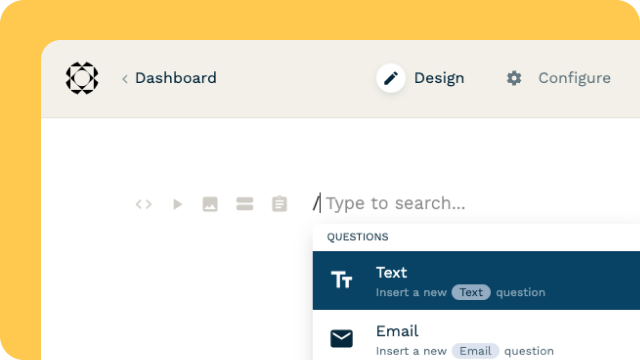
All Solutions

Explore all the solutions you can create with Paperform: surveys, quizzes, tests, payment forms, scheduling forms, and a whole lot more.
See all solutions











Connect with over 2,000 popular apps and software to improve productivity and automate workflows
See all integrationsSolutions
All Solutions

Explore all the solutions you can create with Paperform: surveys, quizzes, tests, payment forms, scheduling forms, and a whole lot more.
See all solutionsIntegrations

Connect with over 2,000 popular apps and software to improve productivity and automate workflows
See all integrationsResources
How to create a registration form in HTML

If you’ve found yourself here, you’ve probably hit some roadblocks while trying to create a registration form in HTML. Don’t worry: you’re not alone. Coding even the simplest of registration forms in HTML can be a time-consuming, often frustrating process.
HTML5 is the standard code used to make most web pages work. It's the language of the internet. But like any language, you’ll need to work hard (and get lost a few times) to become fluent.
We can’t get you to HTML fluency in 3,000 words. But we can give lead you to our Free HTML Form Creator tool that allows you to quickly build HTML forms by adding your questions, configuring options, and generating the HTML code for you to paste on your website.
If you prefer building an HTML from scratch, this post will also give you the basic information you need to create a simple registration form for your website.
Summary
Here's a summary of how to build an HTML registration form. If you're more of a visual learner, we've also got a video tutorial below.
- Create a new HTML file and open it in a text editor.
- Inside the
bodyelement, create aformelement with theactionandmethodattributes set. (Theactionthe attribute specifies where to send the form data, and themethodattribute specifies how to send it). - Create a
labelelement for each field you want the user to fill out. Thelabelshould have aforattribute that matches theidof the corresponding input element. - Inside each
labelelement, create aninputelement with thetype,id,name, andplaceholderattributes set. Thetypeattribute specifies the type of input (e.g. "text", "email", "password", etc.), theidattribute provides a unique identifier for the input, thenameattribute specifies the name of the input field, and theplaceholderattribute provides a hint for the user about what to enter in the field. - Add a
submitbutton to the form to allow the user to submit their information. - Use CSS to style the form elements and make the form visually appealing.
Alternatively, make your life easier by using our Free HTML Form Creator that auto-generates the HTML code for your form, or signing up to Paperform, which empowers you to build beautiful, smart forms in seconds without any code.
Want to build forms with no-code?
Start your 14-day free trial now. No credit card needed.
Creating an HTML registration form in 6 steps
Here’s how to create a simple HTML form in six steps—code included. Read on for a step-by-step walkthrough, or check out the video below.
Step 1. Choose an HTML editor
Just like you need a word processor to create a text document, you need a text editor to create HTML code. These development tools convert the weird and wonderful code you type into a registration form.
If you’re looking for the simplest solution, you could always write out your code in TextEdit on a Mac and save the file as a web page. This won’t give you any frills or additional features, but it’ll get the job done. Go to Format > Plain Text to make sure TextEdit doesn’t alter your symbols.
If you want a designated HTML editing tool, there are dozens (if not hundreds) to choose from. There’s no “best” option, but there are a few key features to look for if you’re going to download a new tool.
1. Error detection: Automatically highlight syntax errors to make fixes easier.
2. Auto-completion: Suggests relevant HTML elements based on previous changes (saves you a bunch of time with long code).
3. Syntax highlights: Applies colours to different HTML tags based on certain categories to make it easier to read and sort your code.
4. Search and replace: Locate and overwrite all instances of a particular code rather than editing each individually.
If you're really getting into coding there are a few more features to look out for, but for making a basic registration form these four should be more than enough.
Now when it comes to picking an app, the choice is yours. There’s no right answer. Want something that you can use in your browser? Try Codepen. Barebones? Notepad++. A minimalistic UI and intuitive input field? Sublime Text all the way.
Our co-founder and resident code-geek, Dean, swears by VS Code.
"From a nerdy standpoint VS Code fits snuggly into Paperform's tech stack and has great remote development plugins that I love. It's great for HTML stuff too, and super customisable if you like your tools to look nice while still having all the functionality you need.
If you’re overwhelmed by the options, we recommend downloading a relatively user-friendly and free option like Sublime Text and learning as you go.
It’s worth noting that most HTML editors won’t come with any form templates—they just give you the blank page. When it comes to creating the form itself, the artistry is all on you.
Step 2. Create your HTML file
Time to get down to business. Open your text editor of choice, create a new file, and save it with the .html extension. You can label your form however you like, like bestformever.html.
Once you've signposted to the editor that you're creating HTML code, it should automatically generate the following code for you:
<!DOCTYPE html>
<html>
<head>
<title></title>
</head>
<body>
</body>
</html>
Some editors won’t autofill. That’s okay. Just copy and paste the code above and you’ll get the same effect.
Step 3. Add basic text fields
Alright. It's time to start adding the relevant code and turn that barebones HTML file into a registration form. Here’s the code we’ll be using.
<!DOCTYPE html>
<html> <head> <h1> Company Registration Form</h1>
</head>
<body>
<form>
<table> <tr> <td> Email Address: </td> <td> <input type=”text” email=””> </td> </tr> <tr> <td> Password: </td> <td> <input type=”Password” name=””> </td> </tr> </table>
</form>
</body>
</html>
If you’re new to HTML, that might just look like a heap of letters and icons. You don’t need to understand what they mean, but troubleshooting is quite a bit easier if you have a handle on the basics.
We’ll break them down below if you’re interested. Feel free to skip ahead if not.
An HTML form is made up of form elements These are things like text boxes, radio buttons, checkboxes and dropdown menus that make it possible for folks to interact with your live form.
Each element has its own specific tag–that’s the word in between the chevrons. For example, the HTML
tag defines your code as a form, whilePaperform Contributor
Deepak (Dee) Shukla, the dynamic founder of Pearl Lemon, built the leading SEO agency in London by l...
Here is the ultimate list of online form builders, what they do best, their pricing, and examples to...
When Luiz Sifuentes lost the platform powering his entire web design business, he rebuilt smarter—wi...
All of our product updates and big company news for Paperform and Papersign from Oct 24 - May 25 to ...